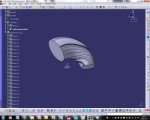Hello all,
New to the site and I'm hoping to get some help. I am a Product Engineer but I sometimes make my own drawings, meaning I know how to use Catia but I don't use it every day and I work mainly with solid models. I'm trying to design a tube made of sheet metal and the best way I would describe it would be; it would be like a cone (small dia of 3.75", large dia of 7", length around 12") but instead of having a straight axis in would be a curve (90 degrees). So basically it's an elbow with two different diameters. I started with a 5" radius and developed a spline to the diameters I wanted but I don't know how to rotate the spline around the radial axis to make the model.
Fyi, the plan will be to send the model to a company to produce a die to stamp the sheet so it really doesn't matter if it is a solid or just the outer surface.
Any ideas on how to do this?
Thanks!
Jim
New to the site and I'm hoping to get some help. I am a Product Engineer but I sometimes make my own drawings, meaning I know how to use Catia but I don't use it every day and I work mainly with solid models. I'm trying to design a tube made of sheet metal and the best way I would describe it would be; it would be like a cone (small dia of 3.75", large dia of 7", length around 12") but instead of having a straight axis in would be a curve (90 degrees). So basically it's an elbow with two different diameters. I started with a 5" radius and developed a spline to the diameters I wanted but I don't know how to rotate the spline around the radial axis to make the model.
Fyi, the plan will be to send the model to a company to produce a die to stamp the sheet so it really doesn't matter if it is a solid or just the outer surface.
Any ideas on how to do this?
Thanks!
Jim


